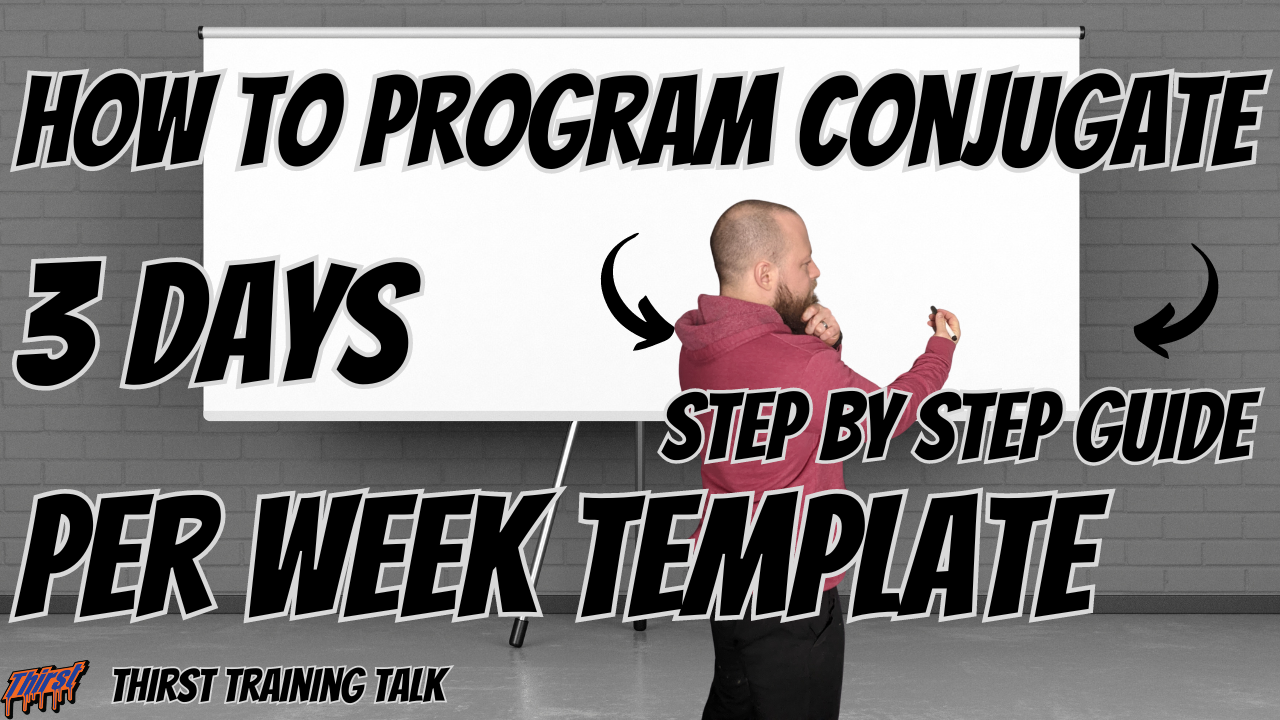Condensed Conjugate Training: A Complete 3-Day Program Guide
For many strength athletes and powerlifters, following the traditional 4-day conjugate method pioneered by Louie Simmons at Westside Barbell can be challenging due to time constraints. In this comprehensive guide, we’ll explore how to effectively adapt the conjugate system into a 3-day training program while maintaining its core principles and effectiveness.
In the video below, I walk you through all this content as well, if you’d much rather watch below.
Understanding the Need for a Condensed Program
The traditional conjugate method requires four training days per week, typically split between max effort and dynamic effort work for both upper and lower body. However, many athletes struggle to consistently attend the gym four times weekly due to work, family commitments, or other obligations. This adaptation provides a solution without compromising the method’s fundamental benefits.
Option 1: The Rotating Schedule Approach
The first and perhaps most straightforward way to condense conjugate training is through a rotating schedule. This approach maintains the integrity of each training day while extending the training cycle.
How the Rotation Works:
- Week 1:
- Monday: Max Effort Lower
- Wednesday: Max Effort Upper
- Friday: Dynamic Effort Lower
- Week 2:
- Monday: Dynamic Effort Upper
- Wednesday: Max Effort Lower
- Friday: Max Effort Upper
- Week 3:
- Monday: Dynamic Effort Lower
- Wednesday: Dynamic Effort Upper
- Friday: Max Effort Lower
This rotation ensures that each training method is still given proper attention, just spread across a longer timeframe. The extended recovery periods between similar training styles can be particularly beneficial for athletes who need more time to recuperate.
Meet Preparation Considerations
When preparing for a competition using the rotating schedule, careful planning becomes crucial. Your final training week should align properly with your meet date, typically ending with:
- A lower body GPP day
- An upper body GPP day
- Two days of rest before the competition
Option 2: The Combined Method Approach
The second option involves condensing the training methods into three distinct days while maintaining weekly exposure to all elements of the conjugate system.
Weekly Structure:
- Day 1: Max Effort Lower
- Day 3: Max Effort Upper
- Day 5: Dynamic Effort Total (Combined)
The Dynamic Effort Total day requires careful planning and execution:
Dynamic Effort Total Day Programming:
- Speed Squats: 8×2 (progressing down to 6×2)
- Speed Deadlifts: 8×1 (progressing down to 6×1)
- Speed Bench: Following similar wave loading
- Accessories: Carefully selected to complement the main movements
Key Programming Considerations:
- Avoid overlapping accessory work between max effort and dynamic effort days
- Incorporate back training across all three training days
- Consider implementing home workouts for additional volume
Option 3: The Hybrid Approach
The third option combines elements from both previous approaches while further condensing the work. This method requires careful exercise selection and timing.
Daily Structure:
- Monday:
- Max Effort Lower
- Dynamic Effort Upper
- Targeted Accessories
- Wednesday:
- Accessory Focus
- Movement Pattern Development
- Recovery Work
- Friday:
- Max Effort Upper
- Dynamic Effort Lower
- Complementary Accessories
Exercise Selection Strategy
When implementing this approach, exercise selection becomes crucial. Each movement should serve a specific purpose and complement the overall training structure. For example:
- Main Movements:
- Rotate between squat and deadlift variations for max effort work
- Maintain consistent dynamic effort patterns while adjusting intensity
- Supplemental Work:
- Choose exercises that address specific weaknesses
- Rotate between variations based on the main movement of the day
Recovery and Volume Management
Regardless of which 3-day approach you choose, managing recovery becomes even more critical when condensing the program. Some key considerations include:
- Total Volume Control:
- Monitor overall working sets
- Adjust accessory work based on main lift performance
- Consider recovery capacity when selecting exercise combinations
- Exercise Selection:
- Choose movements that provide the most benefit for your goals
- Avoid redundant exercises
- Focus on quality over quantity
- Rest Periods:
- Allow adequate rest between similar movement patterns
- Consider your individual recovery capacity
- Adjust training intensity based on performance indicators
Implementation Guidelines
When implementing a condensed conjugate program, consider these crucial factors:
- Individual Response:
- Monitor recovery between sessions
- Adjust volume and intensity based on performance
- Be willing to modify the approach based on results
- Progressive Overload:
- Maintain proper progression in main movements
- Track performance indicators
- Adjust accessory work to support main lift development
- Long-term Planning:
- Structure training blocks appropriately
- Plan deload periods
- Align training cycles with competition schedule if applicable
Conclusion
The conjugate method can be effectively adapted to a 3-day format while maintaining its core principles and benefits. Whether choosing the rotating schedule, combined method, or hybrid approach, success depends on careful planning, proper exercise selection, and intelligent volume management.
Remember that while training frequency is reduced, the quality and intensity of each session become even more critical. Monitor your progress, make adjustments as needed, and stay consistent with your chosen approach. For many athletes, this condensed version might actually lead to better results through improved recovery and more focused training sessions.
The key to success with any of these approaches lies in understanding your own recovery capacity, being strategic with exercise selection, and maintaining the intensity and purpose of each training session. While you may be in the gym less frequently, the effectiveness of your training can remain high through proper programming and execution.
*[GPP]: General Physical Preparedness *[CNS]: Central Nervous System
Need help implementing this in your own training? Book a FREE Discovery Call where we can discuss how we can help improve your training with the conjugate system.








